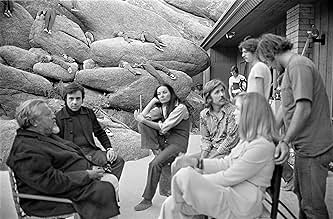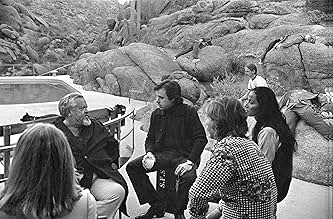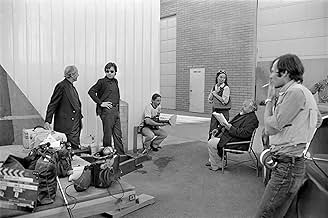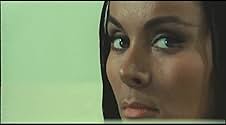VALUTAZIONE IMDb
6,7/10
8255
LA TUA VALUTAZIONE
Un regista di Hollywood emerge dal semi-esilio con l'intenzione di completare il lavoro su un film innovativo.Un regista di Hollywood emerge dal semi-esilio con l'intenzione di completare il lavoro su un film innovativo.Un regista di Hollywood emerge dal semi-esilio con l'intenzione di completare il lavoro su un film innovativo.
- Premi
- 9 vittorie e 8 candidature totali
Robert Random
- John Dale
- (as Bob Random)
Trama
Lo sapevi?
- QuizThe movie was filmed between 1970 and 1976, with editing continuing into the 1980s. When he died in October 1985, Welles left behind nearly 100 hours of footage and a work print consisting of assemblies and a few edited scenes.
- BlooperIn one confrontational scene, Brooks Otterlake, who Gregory Sierra's character, Jack Simon, refers to as, "Kid", is simultaneously Peter Bogdanovich and Rich Little. This is small overlap is because Rich Little was originally cast as the black turtleneck wearing, voice imitating director, Brooks Otterlake. However Bogdanovich replaced him, and Little's part was reduced to that of a Party Guest.
- Citazioni
[last lines]
Jake Hannaford: Who knows, maybe you can stare too hard at something, huh? Drain out the virtue, suck out the living juice. You shoot the great places and the pretty people... All those girls and boys. Shoot 'em dead.
- Curiosità sui creditiAfter the end credits, Hannaford's voice is heard saying "Cut"
- ConnessioniFeatured in AFI Life Achievement Award: A Tribute to Orson Welles (1975)
- Colonne sonoreLes Délinquants
Written and performed by Michel Legrand
Published by WB Music Corp. o/b/o Productions,
Michel Legrand + Editions Royalty
Courtesy of Decca Records France
Under license from Universal Music Enterprises
Recensione in evidenza
The Other Side of the Wind is not a perfect film, but perhaps the perfect film to punctuate Orson Welles' incredible and monolithic career, and certainly the most appropriate film to leave unfinished due to difficulty in production. Or perhaps it is the genius of Welles to have left the film unfinished on purpose?
The film focuses on "the man, the myth, the legend" type J.J. Hannaford, who is making his comeback film after a long hiatus of being out of touch with the modern movie realm. He celebrates his birthday by having a documentary team, friends, associates, and others join him for a showing of his new film "The Other Side of the Wind" starring his striking new lead actor Johnny Dale and lead actress (who is nameless according to the bill). What ensues is a chaotic, fast-paced bombardment of quick edits, snappy dialog, a movin' sound track, and fantastic camera-work sandwiched between the hypnotic, near-legato, orchestral moments of Hannaford's film "The Other Side of the Wind".
It took me about 25 min to get used to the faced-paced, almost bravado tone of the editing because I wanted more time to saturate the emotions and facial expressions of the characters. This is why I think the sections that show Hannaford's film stick out even more though; finally having time to "breath" (if you will) versus the zaniness of being in the business (reality). It even feels at times that Hannaford himself is drowning and just wants to breath. Even still, does Welles conduct an amazing performance from the grizzled-veteran John Huston, who nails the semi-pretentious over-indulgent Hannaford to a tee.
The highlights of Welles' last picture surely come from the technical aspects of the production, the anticipation born from it's long-troubled existence of coming to fruition, and the lead performance from Huston. I must say there are a handful of poignant, enigmatic scenes that truly hypnotize such as "The Other Side of the Wind"s rather incredible car scene, which for me was the true top moment of this feature. The camerawork changing from black and white to deep color is used to great effect as well.
I suppose we will never know if what we have today is truly Welles' vision fully intact, or just a shadow of what is was supposed to be. The Other Side of the Wind is definitely for any fans of Orson Welles and for those who enjoy seeing filmmaking done years ahead of its time. I feel like I must say that this film isn't getting praise from me simply because Welles' name is slapped on it, but good because there are a bunch of things to appreciate.
The film focuses on "the man, the myth, the legend" type J.J. Hannaford, who is making his comeback film after a long hiatus of being out of touch with the modern movie realm. He celebrates his birthday by having a documentary team, friends, associates, and others join him for a showing of his new film "The Other Side of the Wind" starring his striking new lead actor Johnny Dale and lead actress (who is nameless according to the bill). What ensues is a chaotic, fast-paced bombardment of quick edits, snappy dialog, a movin' sound track, and fantastic camera-work sandwiched between the hypnotic, near-legato, orchestral moments of Hannaford's film "The Other Side of the Wind".
It took me about 25 min to get used to the faced-paced, almost bravado tone of the editing because I wanted more time to saturate the emotions and facial expressions of the characters. This is why I think the sections that show Hannaford's film stick out even more though; finally having time to "breath" (if you will) versus the zaniness of being in the business (reality). It even feels at times that Hannaford himself is drowning and just wants to breath. Even still, does Welles conduct an amazing performance from the grizzled-veteran John Huston, who nails the semi-pretentious over-indulgent Hannaford to a tee.
The highlights of Welles' last picture surely come from the technical aspects of the production, the anticipation born from it's long-troubled existence of coming to fruition, and the lead performance from Huston. I must say there are a handful of poignant, enigmatic scenes that truly hypnotize such as "The Other Side of the Wind"s rather incredible car scene, which for me was the true top moment of this feature. The camerawork changing from black and white to deep color is used to great effect as well.
I suppose we will never know if what we have today is truly Welles' vision fully intact, or just a shadow of what is was supposed to be. The Other Side of the Wind is definitely for any fans of Orson Welles and for those who enjoy seeing filmmaking done years ahead of its time. I feel like I must say that this film isn't getting praise from me simply because Welles' name is slapped on it, but good because there are a bunch of things to appreciate.
- Ziglet_mir
- 15 giu 2019
- Permalink
I più visti
Accedi per valutare e creare un elenco di titoli salvati per ottenere consigli personalizzati
- How long is The Other Side of the Wind?Powered by Alexa
Dettagli
- Data di uscita
- Paesi di origine
- Sito ufficiale
- Lingue
- Celebre anche come
- The Other Side of the Wind
- Luoghi delle riprese
- Aziende produttrici
- Vedi altri crediti dell’azienda su IMDbPro
- Tempo di esecuzione2 ore 2 minuti
- Colore
- Mix di suoni
Contribuisci a questa pagina
Suggerisci una modifica o aggiungi i contenuti mancanti

Divario superiore
By what name was L'altra faccia del vento (2018) officially released in India in English?
Rispondi




































